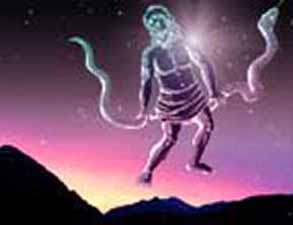

Ophiuchus (known as the serpent holder) is one of the 88 constellations, and was also one of the 48 listed by Ptolemy. Of the 13 zodiac constellations (constellations that can contain the Sun during the course of a year), Ophiuchus is the only one which is not counted as an astrological sign. Ophiuchus is depicted as a man supporting a snake, Serpens; the interposition of his body divides the snake into two parts, Serpens Caput and Serpens Cauda, which are nonetheless counted as one constellation.
Mythology

There are several mythological possibilities for whom the figure represents. The most recent interpretation is that the figure represents the legendary physician Asclepius, who learned the secrets of life and death from one serpent bringing another some herbs which healed it (Asclepius had previously tried to kill it). In order to avoid the human race becoming immortal under Asclepius's care, Zeus eventually killed him with a bolt of lightning, but placed him in the heavens to honour his good works. The involvement in the myth of Chiron may be connected to the nearby presence of the constellation Sagittarius, which was in later times occasionally considered to represent Chiron (who was more usually identified as the constellation Centaurus). Another possibility is that the figure represents the demise during the Trojan War of the Trojan priest Laocošn, who was strangled by a snake or a sea serpent after warning the Trojans against accepting the Trojan Horse. A suggestive statue in the Vatican Museums depicts the tragedy. A third possibility is Apollo wrestling with the Python to take control of the oracle at Delphi.
�H�i�s�t�o�r�y
�J�o�h�a�n�n�e�s� �K�e�p�l�e�r�'�s� �d�r�a�w�i�n�g� �d�e�p�i�c�t�i�n�g� �t�h�e� �l�o�c�a�t�i�o�n� �o�f� �t�h�e� �s�t�e�l�l�a� �n�o�v�a� �i�n� �t�h�e� �f�o�o�t� �o�f� �O�p�h�i�u�c�h�u�s�.� T�h�i�s� �c�o�n�s�t�e�l�l�a�t�i�o�n�,� �k�n�o�w�n� �f�r�o�m� �a�n�t�i�q�u�i�t�y�,� �i�s� �o�n�e� �o�f� �t�h�e� �4�8� �c�o�n�s�t�e�l�l�a�t�i�o�n�s� �d�e�s�c�r�i�b�e�d� �b�y� �P�t�o�l�e�m�y�.� �I�t� �h�a�s� �a�l�s�o� �b�e�e�n� �k�n�o�w�n� �a�s� �S�e�r�p�e�n�t�a�r�i�u�s�,� �a� �L�a�t�i�n� �f�o�r�m� �o�f� �i�t�s� �n�a�m�e�.� T�h�e� �m�o�s�t� �i�m�p�o�r�t�a�n�t� �h�i�s�t�o�r�i�c�a�l� �e�v�e�n�t� �i�n� �O�p�h�i�u�c�h�u�s� �w�a�s� �t�h�e� �S�u�p�e�r�n�o�v�a� �1�6�0�4�,� �a�l�s�o� �n�a�m�e�d� �K�e�p�l�e�r�'�s� �S�u�p�e�r�n�o�v�a�,� �w�h�o�s�e� �e�x�p�l�o�s�i�o�n� �w�a�s� �f�i�r�s�t� �o�b�s�e�r�v�e�r�d� �o�n� �O�c�t�o�b�e�r� �9�,� �1�6�0�4�,� �n�e�a�r� �O�p�h�i�u�c�h�i�.� �J�o�h�a�n�n�e�s� �K�e�p�l�e�r� �s�a�w� �i�t� �f�i�r�s�t� �o�n� �O�c�t�o�b�e�r� �1�6�,� �b�u�t� �s�t�u�d�i�e�d� �i�t� �s�o� �e�x�t�e�n�s�i�v�e�l�y� �t�h�a�t� �t�h�e� �s�u�p�e�r�n�o�v�a� �w�a�s� �s�u�b�s�e�q�u�e�n�t�l�y� �n�a�m�e�d� �a�f�t�e�r� �h�i�m�.� �H�e� �p�u�b�l�i�s�h�e�d� �h�i�s� �f�i�n�d�i�n�g�s� �i�n� �a� �b�o�o�k� �e�n�t�i�t�l�e�d� �D�e� �s�t�e�l�l�a� �n�o�v�a� �i�n� �p�e�d�e� �S�e�r�p�e�n�t�a�r�i�i� �(�O�n� �t�h�e� �N�e�w� �S�t�a�r� �i�n� �O�p�h�i�u�c�h�u�s�'� �F�o�o�t�)�.� �G�a�l�i�l�e�o� �u�s�e�d� �i�t�s� �b�r�i�e�f� �a�p�p�e�a�r�a�n�c�e� �t�o� �c�o�u�n�t�e�r� �t�h�e� �A�r�i�s�t�o�t�e�l�i�a�n� �d�o�g�m�a� �t�h�a�t� �t�h�e� �h�e�a�v�e�n�s� �a�r�e� �c�h�a�n�g�e�l�e�s�s�. �I�t� �o�c�c�u�r�r�e�d� �o�n�l�y� �3�2� �y�e�a�r�s� �a�f�t�e�r� �a�n�o�t�h�e�r� �s�u�p�e�r�n�o�v�a� �i�n� �C�a�s�s�i�o�p�e�i�a� �t�h�a�t� �h�a�d� �b�e�e�n� �o�b�s�e�r�v�e�d� �b�y� �T�y�c�h�o� �B�r�a�h�e�;� �t�h�e� �l�a�s�t� �s�u�p�e�r�n�o�v�a� �b�e�f�o�r�e� �t�h�e�n� �h�a�d� �o�c�c�u�r�r�e�d� �i�n� �1�0�5�4�,� �a�n�d� �a�f�t�e�r� �K�e�p�l�e�r�'�s� �n�o� �f�u�r�t�h�e�r� �s�u�p�e�r�n�o�v�a�e� �w�e�r�e� �o�b�s�e�r�v�e�d� �u�n�t�i�l� �1�9�8�7.
Astrology
�I�n� �t�h�e� �2�n�d� �c�e�n�t�u�r�y�,� �P�t�o�l�e�m�y� �l�i�s�t�e�d� �2�9� �s�t�a�r�s� �i�n� �O�p�h�i�u�c�h�u�s�.� �H�e� �r�e�c�o�g�n�i�z�e�d� �t�h�a�t� �m�o�s�t� �o�f� �t�h�o�s�e� �s�t�a�r�s� �w�e�r�e� �n�o�r�t�h� �o�f� �t�h�e� �e�c�l�i�p�t�i�c� �(�t�h�e� �p�a�t�h� �o�f� �t�h�e� �S�u�n� �t�h�r�o�u�g�h� �t�h�e� �s�k�y�)� �-� �h�o�w�e�v�e�r�,� �4� �o�f� �t�h�e�m� �(�t�o�d�a�y� �k�n�o�w�n� �a�s� �3�6� �O�p�h�,� �4�2�� �O�p�h�,� �4�4� �O�p�h� �a�n�d� �5�1� �O�p�h�)� �h�e� �r�e�c�o�g�n�i�s�e�d� �a�s� �b�e�i�n�g� �s�o�u�t�h� �o�f� �t�h�e� �e�c�l�i�p�t�i�c�.� �T�h�e�r�e�f�o�r�e�,� �t�h�e� �S�u�n� �p�a�s�s�e�d� �t�h�r�o�u�g�h� �t�h�e� �c�o�n�s�t�e�l�l�a�t�i�o�n� �o�f� �O�p�h�i�u�c�h�u�s� �a�s� �i�t� �w�a�s� �r�e�c�o�g�n�i�s�e�d� �b�y� �P�t�o�l�e�m�y�.� �M�a�n�y� �a�s�t�r�o�l�o�g�e�r�s� �(�i�n�c�o�r�r�e�c�t�l�y�)� �s�t�a�t�e� �t�h�a�t� �t�h�e� �p�h�e�n�o�m�e�n�o�n� �o�f� �t�h�e� �S�u�n� �p�a�s�s�i�n�g� �t�h�r�o�u�g�h� �O�p�h�i�u�c�h�u�s� �d�a�t�e�s� �f�r�o�m� �a� �d�e�c�i�s�i�o�n� �b�y� �t�h�e� �I�n�t�e�r�n�a�t�i�o�n�a�l� �A�s�t�r�o�n�o�m�i�c�a�l� �U�n�i�o�n� �t�o� �a�d�o�p�t� �c�o�n�s�t�e�l�l�a�t�i�o�n� �b�o�u�n�d�a�r�i�e�s� �i�n� �1�9�3�0� �-� �i�n� �f�a�c�t�,� �t�h�e� �p�h�e�n�o�m�e�n�o�n� �p�r�e�d�a�t�e�s� �t�h�a�t� �d�e�c�i�s�i�o�n� �b�y� �o�v�e�r� �1�,�7�0�0� �y�e�a�r�s�.� T�h�e� �r�e�a�s�o�n� �w�h�y� �O�p�h�i�u�c�h�u�s� �i�s� �n�o�t� �a� �p�a�r�t� �o�f� �t�h�e� �w�e�s�t�e�r�n� �a�s�t�r�o�l�o�g�i�c�a�l� �z�o�d�i�a�c� �i�s� �b�e�c�a�u�s�e� �t�h�a�t� �z�o�d�i�a�c� �i�s� �d�e�f�i�n�e�d� �o�n� �t�h�e� �b�a�s�i�s� �o�f� �t�h�e� �s�u�n� �s�p�e�n�d�i�n�g� �a�n� �e�q�u�a�l� �a�m�o�u�n�t� �o�f� �t�i�m�e� �i�n� �t�w�e�l�v�e� �a�s�t�r�o�l�o�g�i�c�a�l� �s�i�g�n�s� �s�t�a�r�t�i�n�g� �a�t� �t�h�e� �v�e�r�n�a�l� �e�q�u�i�n�o�x� �-� �t�h�i�s� �i�s� �c�a�l�l�e�d� �t�h�e� �t�r�o�p�i�c�a�l� �z�o�d�i�a�c�.� �T�h�e�r�e� �i�s� �a�l�s�o�,� �f�o�r� �i�n�s�t�a�n�c�e�,� �a� �s�i�d�e�r�e�a�l� �z�o�d�i�a�c�,� �w�h�i�c�h� �i�s� �b�a�s�e�d� �o�n� �t�h�e� �a�c�t�u�a�l� �l�o�c�a�t�i�o�n� �o�f� �t�h�e� �s�t�a�r�s� �i�n� �t�h�e� �s�k�y�,� �a�n�d� �w�h�i�c�h� �i�s� �u�s�e�d� �b�y� �H�i�n�d�u� �a�n�d� �s�o�m�e� �W�e�s�t�e�r�n� �a�s�t�r�o�l�o�g�e�r�s�.� �A�t� �p�r�e�s�e�n�t�,� �t�h�e� �s�u�n� �i�s� �i�n� �O�p�h�i�u�c�h�u�s� �f�r�o�m� �N�o�v�e�m�b�e�r� �3�0� �t�o� �D�e�c�e�m�b�e�r� �1�7�.
Ophiuchus Wikipedia
The primary function of these "medicine men" (who are not always male) is to secure the help of the spirit world, including the Great Spirit (Wakan Tanka in the language of the Lakota Sioux), for the benefit of the community.
Sometimes the help sought can be for the sake of healing disease, sometimes it can be for the sake of healing the psyche, sometimes the goal is to promote harmony between human groups or between humans and nature. So the term "medicine man" is not entirely inappropriate, but it greatly oversimplifies and also skews the depiction of the people whose role in society complements that of the chief. These people are not the Native American equivalent of the Chinese "barefoot doctors", herbalists, or of the emergency medical technicians who ride our rescue vehicles.
To be recognized as the one who performs this function of bridging between the natural world and the spiritual world for the benefit of the community, an individual must be validated in his role by that community.
The medicine man was a very important figure in Native American society. When European missionaries came over to try to convert the Natives into Christianity, the medicine man stood as a major obstacle to the missionaries in trying to convert them.
One of the best sources of information on this subject is the story of a Lakota (Sioux) wicasa wakan ("medicine man") recorded in a book produced with his cooperation called Lame Deer, Seeker of Visions, by John Fire Lame Deer.
On a broader scale, Mircea Eliade's Shamanism puts the whole area of religious experience and practice into a broad historical and ethnographic context.
The term medicine man was also frequently used by Europeans to refer to African shamans, also known as "witch doctors" or "fetish men".